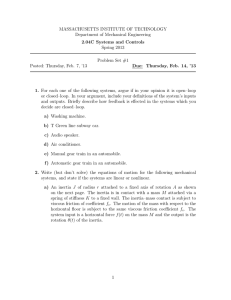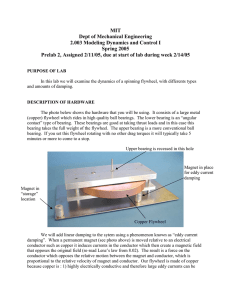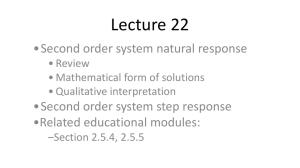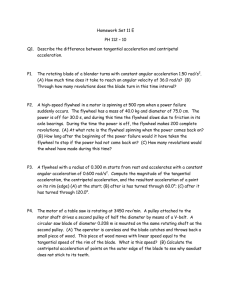Observing 2 order system behavior
advertisement
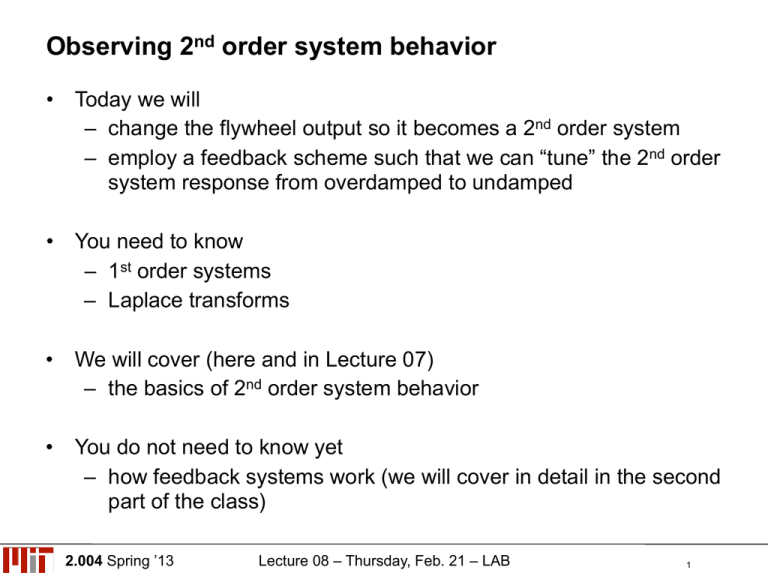
Observing 2nd order system behavior • Today we will – change the flywheel output so it becomes a 2nd order system – employ a feedback scheme such that we can “tune” the 2nd order system response from overdamped to undamped • You need to know – 1st order systems – Laplace transforms • We will cover (here and in Lecture 07) – the basics of 2nd order system behavior • You do not need to know yet – how feedback systems work (we will cover in detail in the second part of the class) 2.004 Spring ’13 Lecture 08 – Thursday, Feb. 21 – LAB 1 Flywheel: switching to angular position as output /1 • We modeled the flywheel as a SISO system with the torque r(t) as input and the angular velocity ω(t) as output. Schematically, r(t) • !(t) R(s) ⌦(s) J !(t) ˙ + b!(t) = r(t) 1 ⌦(s) = R(s) Js + b Time domain (ODE) Laplace domain (TF) Now let us consider instead the angular displacement Z θ(t) as the output. This is related to ω(t) via an integral: t ✓(t) = !(t0 )dt0 0 1 s • In the Laplace domain, the relationship becomes ⇥(s) = ⌦(s) • Using the TF for Ω(s) we obtain 2.004 Spring ’13 1 ⇥(s) = R(s) s(Js + b) Lecture 08 – Thursday, Feb. 21 – LAB 2 Flywheel: switching to angular position as output /2 • Schematically, r(t) • ✓(t) R(s) ⇥(s) ¨ + b✓(t) ˙ = r(t) J ✓(t) 1 ⇥(s) = R(s) s(Js + b) Time domain (ODE) Laplace domain (TF) Some important observations: • the diagrams in this and the previous page correspond to the same physical system; however, the physical quantity that we choose to represent the output is different; • the ODE for θ(t) can be obtained by inverse-Laplace transforming the TF Θ(s)/R(s) [recall that multiplying by s in the Laplace domain is equivalent to taking a derivative in the time domain] or by deriving the equation of motion in the time domain using Newton’s law for rotational systems. The results are of course consistent (check that!) 2.004 Spring ’13 Lecture 08 – Thursday, Feb. 21 – LAB 3 Flywheel with feedback: a “tunable” 2nd order system jω σ b/J 0 The transfer function ⇥(s) 1 = R(s) s(Js + b) has two poles: one at b/J (same as the 1st –order system we had considered earlier, when angular velocity was the output) and one at the origin. The pole at the origin results from the “integrator,” i.e. the integral operation that converts angular velocity !(t) to angular position ✓(t). To make the flywheel response look more like the “standard” 2nd –order system, we can introduce feedback. This is physically implemented by connecting the function generator to the positive inlet of the amplifier and the output of the position meter to the negative inlet and specifying a feedback gain K in the computer interface. Without going into the details of the derivation (we will do that extensively in the following weeks) the transfer function of the system with feedback becomes ⇥(s) K = R(s) Js2 + bs + K The purpose of the lab is to observe experimentally that at “low gain,” i.e. small values of K, the response is overdamped; whereas at “high gain,” i.e. for large values of K, the response becomes underdamped. We will verify these observations with mathematical rigor in the following weeks. For now, please consider K as a “knob” which you can turn to tune the response from overdamped to underdamped. More details will come, we promise! jω σ 0 b/J Low gain (overdamped) jω σ 0 b/J High gain (underdamped) :open-loop poles (no feedback or K=0) 2.004 Spring ’13 Lecture 08 – Thursday, Feb. 21 – LAB 4 Lab procedure • • • • • • First, please read carefully the previous three introductory pages, and make sure you are comfortable with the flywheel as a 2nd order system (now that we’ve defined the angular position as output) and the role of gain K in tuning the transfer function. Derive the roots of the polynomial Js2+bs+K=0 and verify that for small values of K they are both real, whereas for large values of K they form a “complex pair” (i.e. both have the same real part, and the imaginary parts have equal magnitude but opposite signs). With help from your TA, verify all the connections in your system, especially where the inputs and outputs are applied. Identify the definition of K in your digital interface. Now use a step function as input to the flywheel, and try different values of K. Record at least two overdamped responses (for two low values of K) and two underdamped responses (for two high values of K) and the values of K for which you observed them. For the underdamped responses, estimate the values of damping ratio ζ and damped oscillation frequency ωd (you will find definitions of these quantities in Lecture 07.) Hand in printouts of your results (or email in digital form) to the TA at the end of the lab. 2.004 Spring ’13 Lecture 08 – Thursday, Feb. 21 – LAB 5 MIT OpenCourseWare http://ocw.mit.edu 2.04A Systems and Controls Spring 2013 For information about citing these materials or our Terms of Use, visit: http://ocw.mit.edu/terms.
